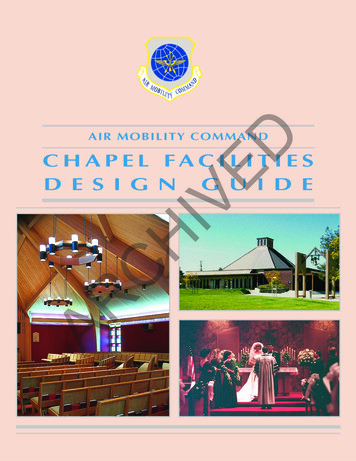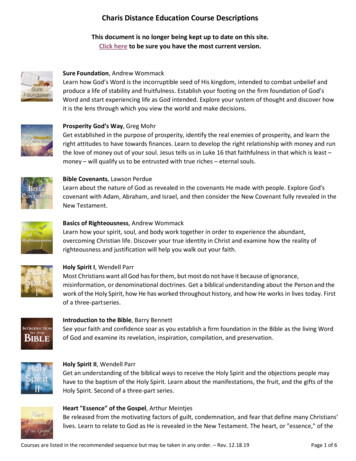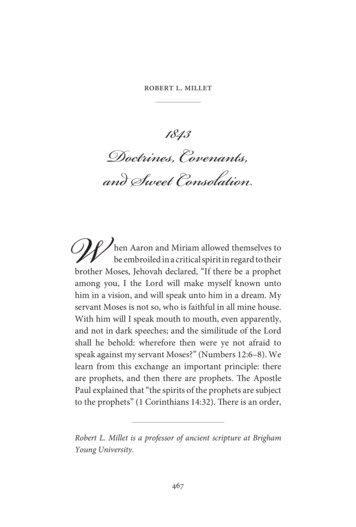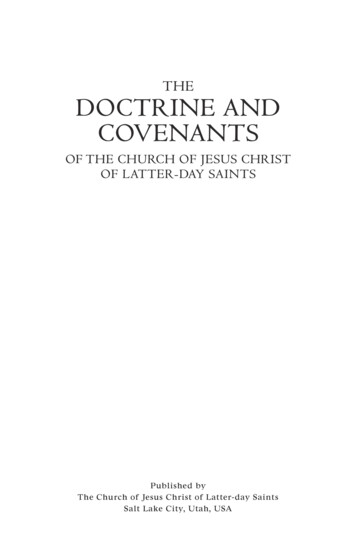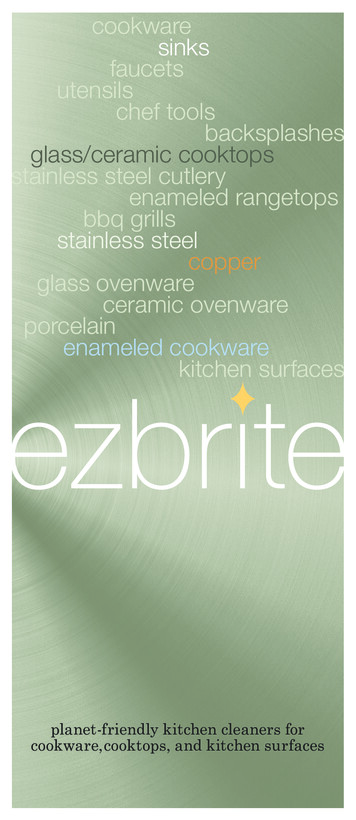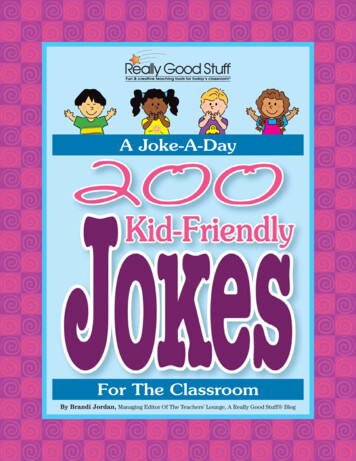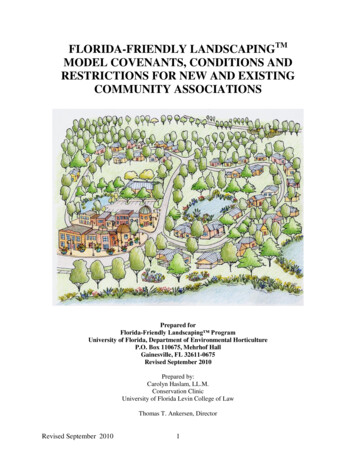
Transcription
FLORIDA-FRIENDLY LANDSCAPINGTMMODEL COVENANTS, CONDITIONS ANDRESTRICTIONS FOR NEW AND EXISTINGCOMMUNITY ASSOCIATIONSPrepared forFlorida-Friendly Landscaping ProgramUniversity of Florida, Department of Environmental HorticultureP.O. Box 110675, Mehrhof HallGainesville, FL 32611-0675Revised September 2010Prepared by:Carolyn Haslam, LL.M.Conservation ClinicUniversity of Florida Levin College of LawThomas T. Ankersen, DirectorRevised September 20101
Contributions by:Nicole C. Kibert & Brett B. Pettigrew, Carlton Fields, PAKathy Malone, Builder & Developer State CoordinatorBetsy Hewitt, Program Attorney, FDEPReviewers:Dr. Michael Thomas, Program Manager, FDEPDr. Esen Momol, Florida-Friendly Landscaping Program DirectorAcknowledgements to those former UF Law Conservation Clinic students and staffand Florida-Friendly Landscaping staff who created original documents:Gina M. Fraga, Srujani Pagidipati, Joshua Muller, Paul Kim,Amanda Perry, Thomas Ruppert (CGR staff attorney and clinic fellow),Holly Johnson Shiralipour, Ondine WellsCover sketch designed by Dr. Gail Hansen, Assistant Professor,University of Florida, Environmental Horticulture DepartmentRevised September 20102
Table of ContentsI. Introduction and Overview . 4II. Background. 4A. Residential Development and Conservation . 4B. Statutory Changes to Encourage Florida-Friendly LandscapingTM . 5C. Introduction to Model Declaration Provisions . 6III. Legal Issues . 7A. Retroactive Application and the Contract Clause of the Florida Constitution . 7B. Reasonableness and Judicial Review . 8C. Aesthetic Regulation by Homeowner Associations . 9IV. Implementing Florida-Friendly LandscapingTM in HOA Documents . 9A. Education . 9B. Selecting Provisions to Incorporate . 10C. Timing . 10V. Model Provisions for a New Communities . 121. Definitions . 122. Landscaping Committee. 133. Landscaping . 154. Irrigation . 225. Surface Water Management; Stormwater; and Low Impact Design . 256. Pest Control . 297. Pets & Wildlife. 308. Wildfire Prevention . 359. Lighting . 3610. Energy Efficiency; Renewable Energy. . 3611. Homeowner Education . 37VI. Model Provisions for Existing Communities . 381. Definitions . 382. Landscaping . 393. Pest Control . 454. Irrigation . 46Revised September 20103
I.Introduction and OverviewResidential development has been a major factor in Florida’s economy for decades, andmuch of that development has taken the form of master-planned communities administered by amandatory homeowners’ association (“HOA”) and set of documents promulgated by thedeveloper or the HOA that may include a declaration of covenants, conditions, and restrictions(“CCRs”); articles of incorporation; bylaws; rules and restrictions; and architectural standards(collectively, “HOA Documents”). Millions of Floridians currently live in such communities,1and most new residential development is likely to take the same form. Unfortunately, HOADocuments that govern both new and existing communities rarely contain restrictions that reflectand permit sustainable approaches to the establishment and maintenance of landscapes.Recognizing the importance of permitting sustainable landscaping in these communities,the Florida legislature enacted a series of provisions in 2009 that updated the definition of“Florida-friendly landscaping” and authorized the use of such landscaping—even when it has thepotential to conflict with existing HOA Documents. Accordingly, it is in the best interests ofdevelopers, HOA boards, and homeowners alike to incorporate Florida-Friendly LandscapingTMprinciples into HOA Documents as they are created or amended to provide clear guidance aboutpermitted landscaping in the community. This report provides background information aboutFlorida-Friendly LandscapingTM, explores legal issues related to the 2009 legislative enactments,and discusses several concerns related to implementing Florida-Friendly LandscapingTMprinciples in HOA Documents. Two sets of model provisions are provided—one for newcommunities and one for existing communities.This report is the result of a joint project between the University of Florida’s Institute ofFood and Agricultural Sciences (“IFAS”) and the Florida Department of EnvironmentalProtection (“FDEP”). It was drafted and revised by the Conservation Clinic at the University ofFlorida’s Levin College of Law (“Conservation Clinic”), with contributions by Carlton Fields,P.A., FDEP and the Florida-Friendly Landscaping Program’s Florida Yards & NeighborhoodsProgram. This report is not intended to confer legal advice. Developers, HOAs, andhomeowners should consult with an attorney before adopting the model provisions providedherein or adapting their landscaping practices in reliance on the 2009 legislation described in thisreport.II.BackgroundA.Residential Development and ConservationGiven the tremendous population explosion in Florida over the past half-century and theinevitability of continued land development in the state, it is imperative for Floridians to find away to coexist with the natural environment. The alternative is permanent loss of valuableresources such as pristine waters and native species. To protect Florida’s fragile environment,1Florida does not regulate HOAs and there is no central repository for information in regards to their numbers.However, a 2007 Florida Senate report used National data to estimate that 4 to 6 million Florida Homeowners live inapproximately 27,000 HOAs. OPPAGA issued a report in February 2010 concluding that there are at least 14,300Mandatory HOAs within the state (Report 10-20)Revised September 20104
developers, HOAs, and homeowners must understand and address the environmental impact oftheir land use decisions. By minimizing their adverse impacts on the environment, theseindividuals and organizations can make a positive difference in preserving Florida’s naturalresources.2As discussed in the introduction to this document, millions of Floridians already live incommunities governed by an HOA, and that number is likely to continue to grow. Research hasshown that few conservation-oriented provisions exist within existing HOA Documents,perpetuating the practices of unnecessary irrigation, and excessive fertilizer use that contribute towater quantity and quality problems.3 Specifically, one recent study shows that there is a stronglink between HOA landscaping practices and nutrient pollution in stormwater.4By incorporating Florida-Friendly LandscapingTM principles into HOA Documents,developers, HOAs, and homeowners can begin addressing these environmental concerns andbring those documents into compliance with the recent legislative changes discussed in moredetail in the following section. Moreover, this can be accomplished without comprising valuessuch as aesthetics and uniformity that are the basis of HOA landscaping standards. This reportprovides model provisions to achieve that goal for new developments, as well as for olderdevelopments that do not have environmentally sustainable landscaping and related provisions intheir original documents. By informing HOAs of simple conservation methods that can beincorporated into their documents, the authors hope that the number of associations that adoptand follow these methods will increase.HOAs may use all or part of the model Covenants, Conditions and Restrictions. To beconsidered “Florida-Friendly,” communities must use maintenance contractors whose employeesare trained in the Green Industries Best Management Practices program,5 have maintenancecontracts that reflect Green Industries Best Management Practices, and provide education to theirproperty managers and residents about Florida-Friendly LandscapingTM design and maintenancepractices at regular intervals—at least once per year. In addition, new communities must addressthe issues in sections 3 – 6 (Section V) in their CCRs, and existing communities must address theissues in sections 2-4 (Section VI). Existing communities may have only their common andmanaged areas certified as Florida-Friendly if they are unable to amend their CCRs, providedthey have contracts, bylaws or written policies in place to require the practices.6B.Statutory Changes to Encourage Florida-Friendly LandscapingTMFlorida law defines the term "Florida-Friendly Landscaping"TM in Section 373.185(1)(b),Florida Statutes:2Florida Yards & Neighborhoods Handbook, A Guide to Environmentally Friendly Landscaping, 2 (2010).Using Science to Influence Policy: Spatial Analysis Comparing Residential Lawn Care Practices and LocalizedWater Pollution, Leesa Souto, UCF Stormwater Academy4Id.5Maintenance companies do not become certified, only individual employees. Under the minimum requirement, thefollowing certification is required: All supervisors and fertilizer/agrichemical applicators must be certified and allemployees should be trained in the BMPs, but laborers that do not apply any chemicals, including fertilizer, need notpass the written examination and may work under the direct supervision of a certified person.6Florida-Friendly Landscaping Program policy, based on Fla. Stat. §403.9337, §403.9338 FS, and FDEP FloridaFriendly LandscapingTM Model Ordinance (2010).3Revised September 20105
“Florida-friendly landscaping” means quality landscapes that conserve water,protect the environment, are adaptable to local conditions, and are droughttolerant. The principles of such landscaping include planting the right plant in theright place, efficient watering, appropriate fertilization, mulching, attraction ofwildlife, responsible management of yard pests, recycling yard waste, reductionof stormwater runoff, and waterfront protection. Additional components includepractices such as landscape planning and design, soil analysis, the appropriate useof solid waste compost, minimizing the use of irrigation, and proper maintenance.This statutory definition mirrors the principles of the Florida-Friendly Landscaping Program, which states that a Florida-friendly landscape is one where the right plants are in theright place, watering is done efficiently, fertilizing is done appropriately, mulch is used, wildlifeis attracted, yard pests are managed responsibly, yard waste is recycled, stormwater runoff issignificantly reduced, and the waterfront is protected from pollutants.7Perhaps more importantly, Section 720.3075(4)(b), Florida Statutes (“FF HOA Law”)was enacted in 2009 and provides:Homeowners’ association documents, including declarations of covenants,articles of incorporation, or bylaws, may not prohibit or be enforced so as toprohibit any property owner from implementing Florida-friendly landscaping, asdefined in s. 373.185, on his or her land or create any requirement or limitation inconflict with any provision of part II of chapter 373 or a water shortage order,other order, consumptive use permit, or rule adopted or issued pursuant to part IIof chapter 373.Therefore, existing communities with potentially conflicting landscaping requirements shouldrevise their documents to ensure that applicable provisions do not violate the FF HOA Law—andmore importantly, do not cause confusion for homeowners about landscaping requirements fortheir lot.C.Introduction to Model Declaration ProvisionsThe previous version of this report outlined the first concise guidelines to developersinterested in incorporating Florida-Friendly LandscapingTM practices into site plans and HOADocuments. Adding these provisions into the community’s declaration of covenants makes themenforceable as the “law” of the community, and that creates certainty throughout the lifetime ofthe project. Therefore, a developer and the homeowners may have confidence that a projectintended to be marketed and sold as “Florida-friendly” will retain many of the environmentalcharacteristics that attracted buyers in the first place.87Florida Yards & Neighborhoods Handbook 3rd Edition, A Guide to Florida-Friendly Landscaping (3rd ed. 2006).The Florida Yards & Neighborhoods Handbook 4th Edition. (4th ed. 2009)8But see Patrick A. Randolph, Jr., Symposium: Common Interest Development Communities: Part II: Changing theRules: Should Courts Limit the Power of Common Interest Communities to Alter Unit Owners’ Privileges in theFace of Vested Expectations?, 38 Santa Clara L. Rev. 1081, 1105 (1998) (noting that courts do not protect anexpectation that a development within a subdivision will remain unchanged, but rather only assure that the changeswill be uniform in application).Revised September 20106
In drafting the model provisions included in this document, the Conservation Clinicresearched the most appropriate conservation methods available within the parameters of theFlorida Yards and Neighborhoods program of Florida-Friendly Landscaping . In researchingwater conservation methods and Florida-Friendly LandscapingTM techniques, the ConservationClinic reviewed the CCRs of various communities, spoke with conservation professionals, andexamined applicable Florida laws. Even though there are different, effective conservationmethods for the various regions of Florida, the Conservation Clinic decided upon a statewideapproach when choosing what type of CCRs to include. After drafting the first version, theConservation Clinic sought the advice of various developers and conservationists across the stateconcerning the practical application of these CCRs. The model provisions offered in this finaldocument reflect the points and concerns of these professionals.These model provisions may be used by developers or HOAs to incorporate FloridaFriendly LandscapingTM principles into the HOA Documents that govern their communities.The updated model language is divided into two forms to make these model provisions moreaccessible to both new and existing communities. The first form, found in Part V of thisdocument, is intended to be used by developers as guiding principles when drafting initialrestrictive covenants or, as they are commonly known, the Declaration of Covenants, Conditionsand Restrictions (“CCRs”). The second form, found in Part VI of this document, is intended forassociations that wish to modify their existing landscaping provisions to be consistent with theFF HOA Law, which now has retroactive application.III.Legal IssuesA.Retroactive Application and the Contract Clause of the Florida ConstitutionThe FF HOA Law purports to have retroactive applicability such that no HOADocument—regardless of when it was created—may prohibit a homeowner from installingFlorida-Friendly LandscapingTM. The express or implied retroactivity of a statute alwaysrequires a careful scrutiny from the standpoint of constitutionality. The Florida Constitution,Article I, Section 10 prohibits the passing of laws “impairing the obligation of contracts”(“Contract Clause”). Therefore, Florida laws may be declared invalid if they impair the rights ofthose who have made existing contracts—which can be problematic for laws that haveretroactive reach. Although courts have strictly applied the restriction on the impairment ofcontracts in the past, they have also exempted laws when there is an “overriding public necessityfor the state to exercise its police powers.”9 So, the Contract Clause does not “prohibit the statefrom enacting legislation with retroactive effect,”10 but rather, courts must look at the purpose ofthe law. Legislation that restricts the right to contract will not be invalid if the restriction isintended as “reasonable and necessary to serve an important public purpose,” 11 which mayinclude protection of the “public’s health, safety or welfare.”129Park Benziger & Co. v. Southern Wine & Spirits, Inc., 391 So2d 681 (Fla. 1980)Yellow Cab C. v. Dade County, 412 So2d 395 (Fla. 3rd DCA 1982), petition den. 424 So2d 764 (Fla. 1982)11Id.12Khoury v Carvel Homes South, Inc., 403 So2d 1043 (Fla. 1st DCA 1981), petition den. 412 So2d 467 (Fla.1981)10Revised September 20107
Accordingly, when laws that may impair existing contracts are passed, courts haveattempted to reach a compromise between individual rights and public welfare. 13 Courts haveapplied this compromise as a balancing test, weighing the “nature and extent of the impairment isconstitutionally tolerable in light of our important state objective, or whether it unreasonablyintrudes into the parties’ bargain to a degree that is necessary to achieve the objective.”14In the FF HOA Law, the Florida Legislature noted that the “use of Florida-FriendlyLandscaping and other water use and pollution prevention measures to conserve or protect thestate’s water resources serves a compelling public interest and that the participation ofhomeowners’ associations and local governments is essential to the state’s efforts in waterconservation and water quality protection and restoration.”15 Because the legislature has foundthat water conservation through appropriate landscaping technologies serves a compelling publicpurpose, retroactive application of the FF HOA law appears to be constitutionally appropriateinsofar as the prohibition on impairment is concerned. As a result, any HOA that properlyamends its governing documents in accordance with the requirements of the HOA Documentsand the applicable statutes should be protected from challenges based on impairment ofcontracts.16B.Reasonableness and Judicial ReviewFlorida-Friendly LandscapingTM provisions of HOA Documents (both new and amended)must be drafted in such a way that they are legally enforceable. Since the FF HOA law isrelatively new, courts have not had the opportunity to interpret its meaning. Analogies may bedrawn, however, from cases that deal with amending or enforcing restrictive covenants insubjects unrelated to water conservation or landscaping.Rules included in CCRs at the time a purchaser purchased his or her property arepresumed to be valid since the purchaser had adequate notice of HOA Documents before buyinga lot and voluntarily chose to purchase lots encumbered by the restrictions in those HOADocuments.17 Therefore, some provisions included in HOA Documents do not necessarily haveto be deemed reasonable since the court will uphold them as long as they are not “clearly‘ambiguous,’ applied arbitrarily, or violative of public policy or a fundamental constitutionalright.”18When dealing with amendments to HOA documents enacted after a purchaser acquiredhis or her property, however, the reasonableness standard comes into play. Generally, courts aremore generous when reviewing amendments voted on by property owners rather than unilateral13Pomponio v Claridge of Pompano Condominium, Inc., 378 So2d 774 (Fla. 1979)Park Benziger, 684-515Fla. Stat. §373.185(3)(a) (2010) (emphasis added)16Id.; See also Park Benziger supra note 9; See also Yellow Cab supra note 10.17Hidden Harbour Estates v. Basso, 393 So. 2d 637, 639 (Fla. Dist. Ct App. 1981).18Zelica M. Grieve, Note and Comment: Latera v. Isle at Mission Bay Homeowners Ass’n: The Homeowner’s FirstAmendment Right to Receive Information, 20 Nova L. Rev. 531, 542 (1995) (quoting in part from ConstellationCondominium Ass’n v. Harrington, 467 So. 2d 378, 381 (Fla. Dist. Ct. App. 1985) and citing to Hidden HarbourEstates v. Basso, 393 So. 2d 637 at 640).14Revised September 20108
amendments enacted by the HOA or an equivalent representative group.19 The only discerniblelimitation placed on any covenant amendment seems to be that it must preserve the “basicexpectations created in the original scheme” of development.20 Developers may also haveretained some power to make unilateral amendments to HOA Documents before control of theHOA is turned over to homeowners, but such power must be exercised in a reasonable mannerand must preserve the original scheme of development.21 Some states have an additional judiciallimitation on amendments to the restrictive covenants that requires all property owners have tobe affected equally by any modification.22C.Aesthetic Regulation by Homeowner AssociationsHOAs have expressed concern that the FF HOA Law will limit the ability of the HOA toprovide aesthetic regulation of the landscaping and yards within the community. It is the positionof FDEP and IFAS, that the FF HOA Law does not eliminate the ability of the HOAs to createand enforce aesthetic standards related to landscaping, so long as those decisions or regulationsdo not violate the accepted practices, procedures and materials outlined in the FF HOA law andmirrored in the Florida-Friendly Landscaping Program. It is the hope of FDEP and IFAS,however, that existing HOAs will take advantage of the model provisions included in thisdocument and proactively amend their HOA Documents where necessary in order to promotesustainable landscapes. Such proactive steps can reduce community conflict by providing allhomeowners with clear guidance as to Florida-Friendly LandscapingTM principles, whilepromoting consistency and property values within the community.IV.Implementing Florida-Friendly LandscapingTM in HOA DocumentsEducation is the key step in making a good decision—whether you are a Developer,HOA, or homeowner. With the knowledge that comes from education on the relevant issues,informed decisions can be made. This section provides a guideline to the information and furtherresearch that may be necessary during the process of creating a CCR document. Finally, it isimportant to keep timing in mind, as it is much simpler to make changes at some times than atothers. All of these elements must be evaluated during this process, in order to create the mosteffective and flexible document that is easy for all parties to understand, as well as associationsto enforce.A.EducationThe annotations and footnotes serve to guide the reader by giving backgroundinformation or explanations that clarify certain provisions. The goal of achieving environmentalimpact reductions by using best management practices will be achieved as more communitiesincorporate provisions such as the ones provided in this document into their own CCRs. A keyaspect to achieving this goal is homeowner education in regards to protecting water quality,19See Hidden Harbour Estates, 393 So. 2d 637 (board adopted lawn watering and well building restriction tocontrol water salinity problem in community); Nelle v. Loch Haven Homeowners’Ass’n, Inc., 413 So. 2d 28 (Fla.1982)20See Randolph, supra note 3 at 1119.21Nelle, 413 So. 2d at 29.22See Randolph, supra note 3 at 1103.Revised September 20109
water savings and other financial savings related to conservation and Florida-FriendlyLandscapingTM by the developer or by the community’s association.Given the complexity of the subject and the possibility of new technical data andgovernment regulation in the field of water conservation, landscaping, and pollution prevention,the information provided in this report may need to be supplemented. The IFAS extension officeat the University of Florida works diligently to keep up with the latest trends in these fields andshould be contacted for more information. UF/IFAS also has offices in counties around the state,which can be located on the web at http://fyn.ifas.ufl.edu or http://FloridaYards.org orwww.SolutionsForYourLife.org/fyn or contacted at (352) 245- 4518. Also, homeowners wishingto obtain additional recommendations for a specific region in Florida may check updatedversions of other University of Florida’s IFAS publications at http://edis.ifas.ufl.edu/ orwww.SolutionsForYourLife.com.B.Selecting Provisions to IncorporateDevelopers, HOAs, and homeowners should bear in mind that the model Florida-FriendlyLandscapingTM provisions in this document are only one approach to enhancing the sustainabilityof landscaping in Florida. There are many additional effective conservation methods available,and the educational resources described in the previous section may be consulted for additionalinformation on the latest conservation methods and ideas.This document provides sample language for community landscape regulation that, takentogether, establishes a system to effectively implement and enforce Florida-FriendlyLandscapingTM. By no means is it to be considered a complete CCR or a substitute for formallegal advice. A lawyer should always be consulted in the drafting of important governingdocuments and changes necessary to accommodate specific site conditions and documentsrequirements. Drafters should also consult relevant municipal and state laws, which prevail overany of the model language set forth herein. Any language included in a CCR that goes againstlaw or public policy will be deemed invalid.23C.TimingInclusion of Florida-Friendly LandscapingTM provisions is most easily accomplishedwhen HOA Documents are initially drafted by the developer’s counsel, and it may also allow theprovisions to be coordinated with other environmentally-friendly planning and design efforts bythe developer. Inclusion of such provisions may also be accomplished easily prior to turnover ofcontrol of an HOA to the homeowners if the developer reserved the right to unilaterally amendthe HOA Documents to incorporate such provisions.24Once a developer has turned control of the HOA over to the community’s homeownersmaking changes to HOA Documents becomes significantly more difficult. Following turnover, adeveloper is prohibited from making unilateral amendments if they had that right initially in the236A Patrick Rohan, Real Estate Transactions: Home Owner Associations and PUDs – Law and Practice, §8.008.28, (1977).ui624Nelle, 413 So. 2d at 29.Revised September 201010
HOA Documents.25 Unless otherwise provided in the HOA Documents, by statute the HOA mayonly amend the HOA Documents if a quorum is obtained at a properly noticed meeting and acertain percentage of these owners present vote in favor of the amendment at that meeting.26 It isimportant for an HOA to consult with an attorney to determine what action will be necessary forthe board vs. the members of the HOA to enact Florida-Friendly LandscapingTM provisions.In any event, whenever Florida-Friendly LandscapingTM provisions are incorporated intoHOA Documents after the initial drafting—whether by the developer or the HOA—it isimportant to seek input from homeowners, for it is homeowners that must adhere to theprovisions on a daily basis and homeowners that make up the Landscaping Committee that willeventually enforce the provisions. There are many methods to solicit homeowner input, but itmay be most effective to use an inclusive, cooperative approach such as a charrette or similarmethod. Charrettes allow all of the parties to work together in order to design a CCR documentthat would be accepted by the majority of participants.2725Fla. Stat. §720.3075(1)(a) (2010)Fla. Stat. §720.306(1) (2010)27For more information on the charrette method, please see the National Charrette Institute website athttp://www.charretteinstitute.org/26Revised September 201011
V.Model Provisions for a New CommunitiesDECLARATION EXHIBITFLORIDA-FRIENDLY DEVELOPMENTCOVENANTS, CONDITIONSAND RESTRICTIONS1.Definitions(Note: The drafter will need to check any existing definitions in the Declarationfor consistency with defini
Sep 20, 2010 · Gina M. Fraga, Srujani Pagidipati, Joshua Muller, Paul Kim, Amanda Perry, Thomas Ruppert (CGR staff attorney and clinic fellow), Holly Johnson Shiralipour, Ondine Wells Cover sketch designed by Dr. Gail Hansen, Assistant Professor, Uni

